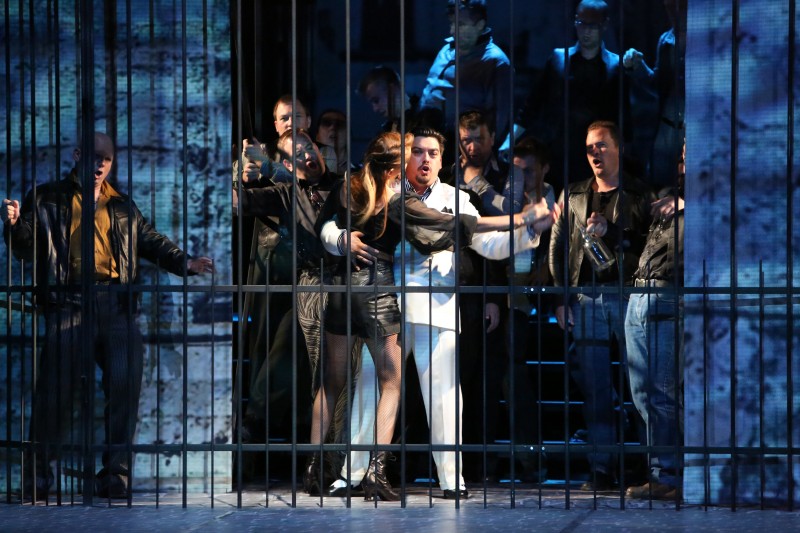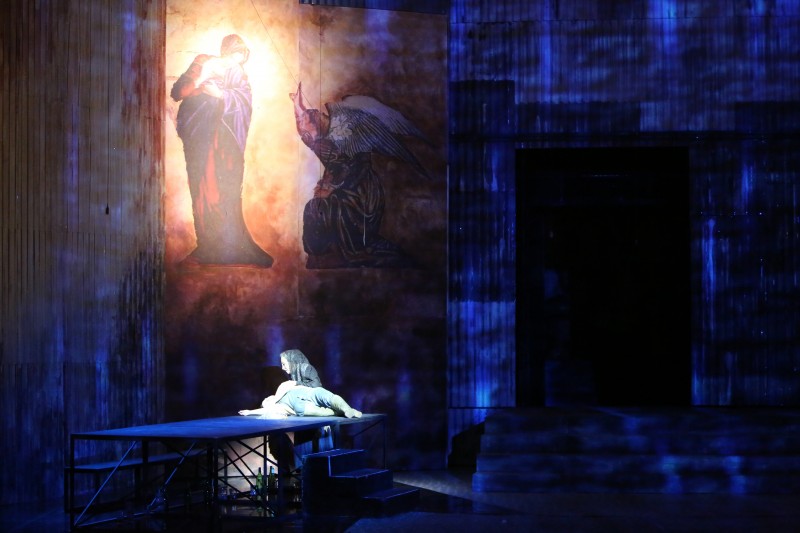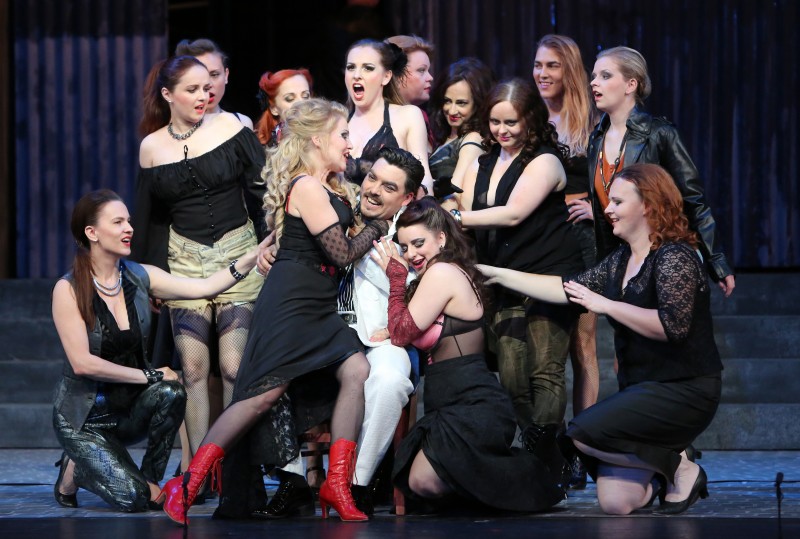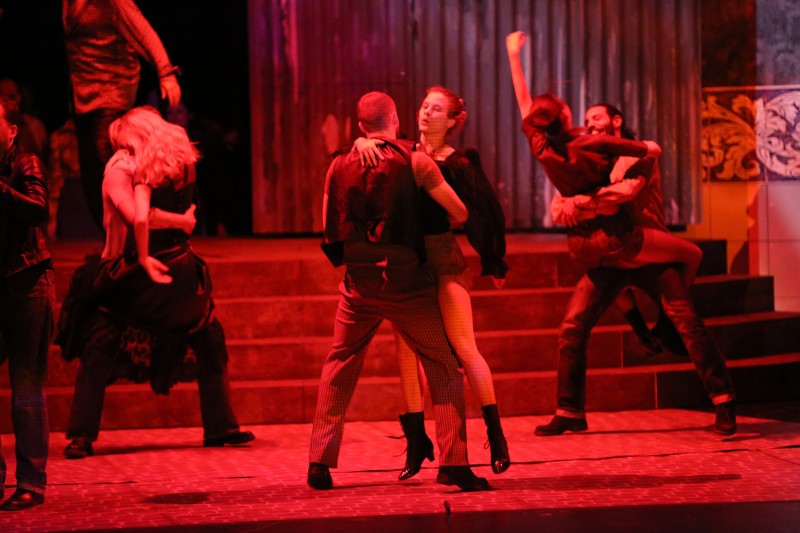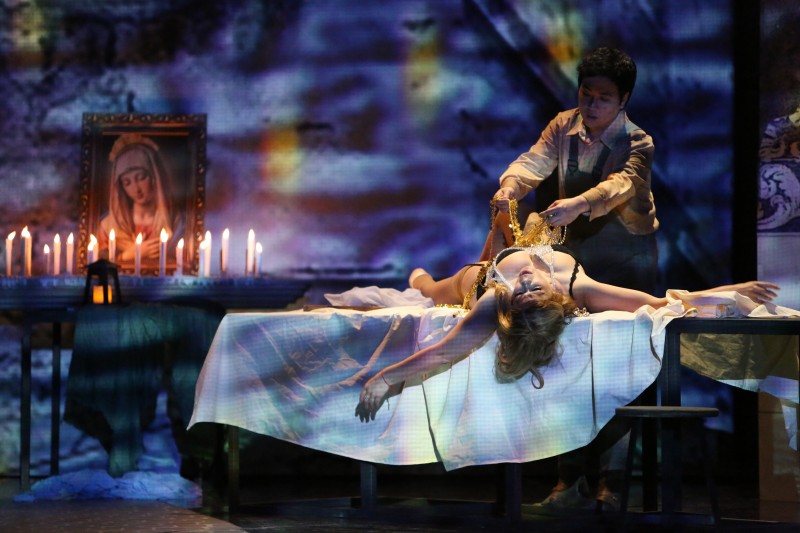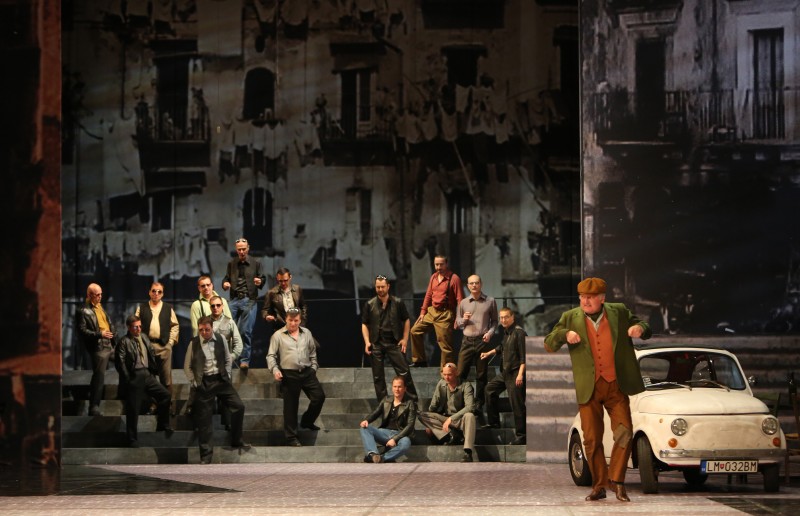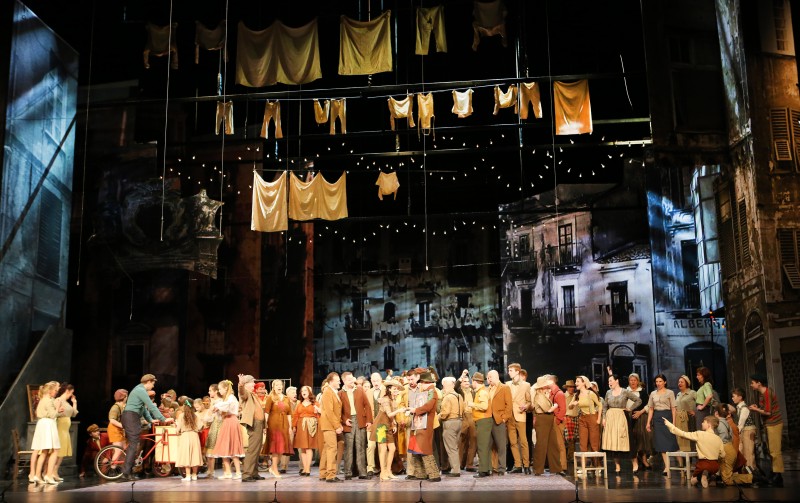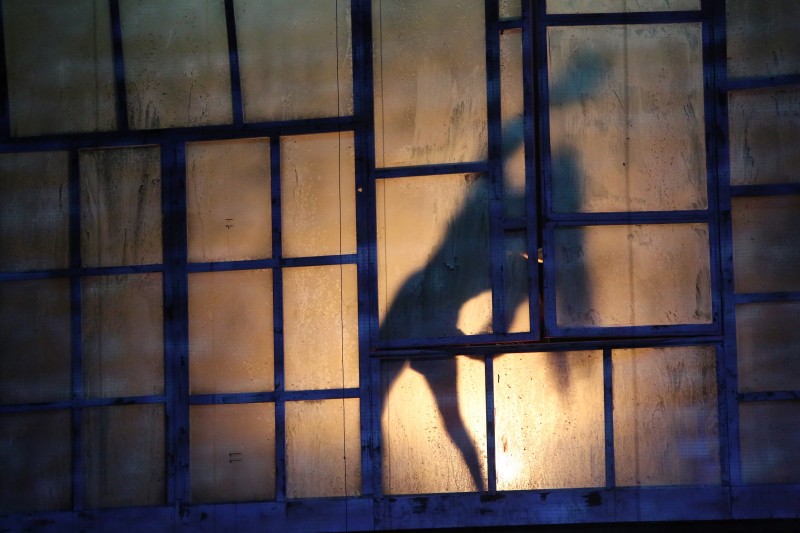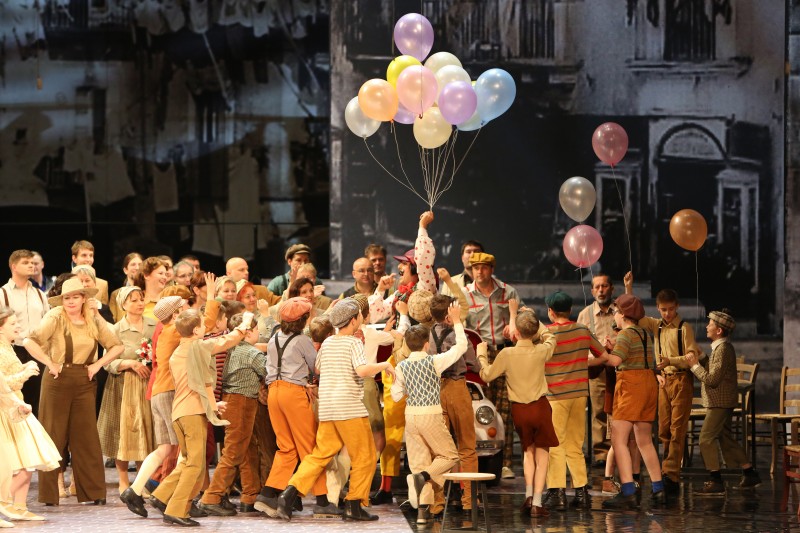I gioielli della madonna
Slovak national theatre – Bratislava
I gioielli della madonna
Wolf-Ferrari
Premier: 29. May 2015
Director: Manfred Schweigkofler
I gioielli della Madonna (English: The Jewels of the Madonna) is an opera in three acts by Ermanno Wolf-Ferrari to an Italian libretto by Carlo Zangarini (it) and Enrico Golisciani, based on news accounts of a real event.
It was first performed at the Kurfürstenoper in Berlin on 23 December 1911 under the title Der Schmuck der Madonna. That performance was in German, but now it is usually given in Italian. Its controversial themes include love between a brother and his adopted sister, implied criticism of the Catholic Church, and an on-stage orgy.
Dirigent: Friedrich Haider
Director: Manfred Schweigkofler
Sets: Michele Olcese
Costumes: Concetta Nappi
Choreograph: Jaroslav Moravčík
Cast:
Gennaro Michal Lehotský / Miroslav Dvorský
Carmela Jitka Sapara-Fischerová / Denisa Šlepkovská
Maliella Adriana Kohútková / Natalia Ushakova
Rafaele Daniel Čapkovič / Sergej Tolstov
Biaso Igor Pasek / Ivan Ožvát
Ciccillo Jozef Kundlák / Róbert Remeselník
Rocco Ján Ďurčo / Roman Krško
Stella Jana Bernáthová / Andrea Vizvári
Concetta Eva Šeniglová / Miriam Garajová
Serena Jitka Sapara-Fischerová / Denisa Šlepkovská
Totonno Ján Babjak / Martin Gyimesi
Manfred Schweigkofler: Opera The Jewels of Madonna has a spirit of idealized realism
By Ján Marták on 27. MÁJ 2015Rozhovory, Sezóna 2014/ 2015
“I want stories and emotions” – is the title of stage director Manfred Schweigkofler’s Credo, in which he besides others says: “I am – proudly – very conservative director. I want stories. And I want emotions. The people need stories because these are not optional but essential for our development and life. The stories and emotions are the being and the substance of theatre. The theatre is a place, where we cultivate the narration of stories and by this way we can cover the primeval need of mankind – also today’s modern enlightened postpostmodern mankind.”
Previously you have done a lot of things, you was an actor, the stage director of dance shows, musicals and others. How did you become a stage director of operas?
It started that in 2001 I became a director of opera house in Bolzano although at that time I did not know much about opera because my story was another one. I was a rock singer, I did various big events, theatre and musicals, so it was very strange when I was offered to direct an opera house, but I think I was a very good and well known cultural manager and therefore they called me. At first, I looked at this opera staff and I really felt not satisfied with what I saw on “my” stage. And then I tried to find my way what would I do making an opera I would like. So I brought a lot of theatric staff and I tried to work in a drama way with the singers. I tried to tell them “Feel every sentence, which you are singing, don’t sing it only but feel what the story is behind”. For me an opera is nothing else than the musical theatre, mainly theatre!
You are a modern and experienced stage director with original views. Now you are performing the stage direction of pretty but almost forgotten opera. This is rather unusual situation, which perhaps demands some specific approach.
This is always the old question how to find the right way to do the particular piece. There are some pieces where you can do almost everything. For example Shakespeare’s plot is so strong that you can put the opera after him to modern times, to psychological hospital or to Wild West and it will still work. However, not every opera is working in every way. I was thinking very long because usually in my staging I don’t like that kind of “verismo” with naturalism, I prefer other pictures on the stage. But reflecting I found that only nearly realistic approach is the correct way for “I gioielli della Madonna”. So the idea was to bring on the stage really “Napoli dei mille colori” ‑ Naples of the thousand colours. Because I think, if it’s not done by this way you cannot express the spirit of Ermanno Wolf-Ferrari. He wanted to show really the living Naples ‑ the shouting, the children running on the street, people having fun and being angry. I think this was the spirit. I really cannot bring other view than to try to give this opera in somehow realistic way using some metaphors. So I said to my set designer “Please, don’t do realistic Napoli, but a kind of hyperrealistic idealized Napoli”. I think this could be an approach and the same refers to the costumes. We are not truly historical but we are portraying what could be historical. So it’s a kind of old fashioned hyperrealism.
So how will the stage design look like?
Scéna sa vyvíjala a veľa vecí sa postupne menilo. Keď sme dokončili druhé dejstvo, mal som z toho radosť, najmä keď k nemu pribudli veľmi pôsobivé oltáre a modlitebne. The set design underwent the development and the things were changing. When the second act was finished I was very happy with it especially when the altars, the tabernacles, which should be a strong impact, were added. You see, doing the stage is a creative process, from this viewpoint it is the same like the work with the orchestra. You need a time to develop it and it cannot be finished at the first patch. As I told I want to show surely hyperrealistic Napoli, which is more in our imagination than in the reality like the story of Maliella and Gennaro is also more in our imagination and not in the reality. This is the art of thinking on what could be more than what is. Let’s think what could be and then it’s interesting. And this leads us away from realism and naturalism.
From various encyclopaedic sources I acknowledged that The Jewels of Madonna is a veristic opera. However, as follows from your intensions related to the stage design this should not be taken so strictly…
I think this opera is very difficult to make not only for the singers; it is not easy musically, rhythmically and for the composition of the stage director as well. There are so many little roles, several choruses – big chorus, small chorus, tiny-tiny chorus, so you have to organize many actions. On the other hand there is some kind of psychedelic points like in the second act when Gennaro brings the jewels to Maliella. This sounds like Pink Floyd in the 70’s so that Ermanno Wolf-Ferrari did not think only in the intentions of “verismo” but he had also other very interesting and wired ideas. There can be heard the popular colour of banda, the themes of Napoli with mandolins, which are typical instruments in this region. But there are also very, very interesting musical moments, which are neither popular nor traditional, but they are kind of really deep psychology music.
Generally, inside this opera is more than we could see at the first moment. It’s also a little Carmen story because like José is able to do everything for Carmen, Gennaro is ready to do everything for Maliella. He has confusion in his head because Maliella is a kind of “Madonna/Mamma/Maliella” so it’s the mother, it’s the lover, it’s the saint. So it’s really quite difficult to make this opera but at the same time I think that it has many, many, very beautiful moments. I cannot understand why it is not played because there are so many worse operas, which are performed quite often.
Let’s try to characterize the roles: Rafaele – it’s probably a rough simplification to say that he is only a bad man…
Of course. He is the “camorrista”, who has been the “camorrista” from his origin. We have a wrong understanding on what criminality is because if we look in our days at the mafia or camorra or also the ISIS: we call them only terrorists and murders but why do they have so many fans? Because they are doing also a social work; they feed the people, they give a work to the people. It’s a terror organisation but this terror is not only killing, it’s also organizing. In sudden meaning the camorra and mafia is really not only killing: this is a parallel social system, which allows the people who are a part of it to feel better than the people outside. So the camorra leader is a very respectable and honourable man in the village. I don’t like the mafia and I think it would be better not to have it but to the vacuum, which was for centuries ceaselessly present in Napoli, the camorra obviously went in and became the system parallel to the state. So the leaders of camorra are usually not just that angry people but they are like leaders of the village. Rafaele is also this type of leader and the mafia possesses very high moral standard in turn. Since the state rules are lost the camorra by their own rules forms very sophisticated inner moral system. Therefore also Rafaele can say at the end of the opera “We, camorrists, we are honourable people, we would never steel the jewels of Madonna” – we might kill if somebody is our enemy but we would never go to church and steel something because our moral codes are very strong.
Should this be called as any kind of double morality?
It’s not a double morality. It’s always a question what is your higher morality standard. If, like in our society, the standards are fading out then everything starts to have the same value. But if you become a member of tribe like the mafia or the camorra – and the camorra is a real tribe – you get very clear standard and the clear standard is “Don’t touch the wife of your friend”. Therefore, from the moment when Gennaro had sex with Maliella, she could no longer be the girl of Rafaele although he is really in love with her. So this is a very clear moral standard. I am really not a friend of the mafia people but I have to say honestly that they have standards of morality in that categories where the people usually don’t have them and these standards are very high and respected.
What kind of girl is Maliella
Maliella is the girl who wants freedom, liberty. So the theme of Maliella is “Il mar catene non ha” – The sea has no chains. She is a girl discovering herself as a women but she is closed in a very bigot home. Outside this home is the life, the forbidden fruit and she is really a girl who wants more, who wants to discover a life. In fact she is very near to every girl in the 70’s who went to become a hippie or a rock’n roll groupie or to the young gothic ladies in our days who want to break out from their very familiar home. She finds Rafaele who promises her the life outside home: “Come to my cord, you will be a princess” But she totally falls in love more with the idea of being free and being “heroine just for one day” like David Bowie sings.
So the story is in fact very contemporary…
Yes, this could happen in a very strong patriarchal society, in so many Turkish or Islamic families with a strong religious meaning on everything but outside is the life, the party, the tease going on while the girls and youngsters want to be a part of this. This could be a today story in Iran with life in a strong religious habitat but at the same time there are parties, disco-clubs. You want to visit them but your brother and mother say “Don’t go there”. So this story is contemporary in many pieces of the today’s world.
Does Gennaro really want to save Maliella or is he just gelous?
He wants really to save Maliella because he absolutely believes that dealing with the camorra is not a good thing. From this side he is obviously totally right, he says “Don’t go there and don’t go with Rafaele because it’s dangerous, you will not have a quiet life” – this is all right. First of all he is a lover but he is also a boy who really tries to help Maliella. However, as totally fallen in love with Maliella and crazy about her, he does crazy things like steeling the jewels.
First act is in high contrast to the third act but they are musically very complementary. At the end of the third act the situation abruptly turns from the really decadent party back to the Madonna adoration. If the situation wouldn’t be so tragic one could laugh on it…
Yes, but you should laugh, because at the end we have the associated short musical reprise of the first act. At the end again sounds the melody “O Napoli bella più mille colori”. So, finally the story of Gennaro, Maliella and Rafaele is just a little episode in a bigger context. This is one of the thousands of thousand stories going on in Naples. Therefore, even if we spend this individual tragedy the life in Napoli will go on because we can never stop it. Also the Madonna tradition, the religious as well as camorra feeling will go on because we are never strong enough to change this culture. So Napoli will survive anyway and no Vesuv, no American invasion can stop its life. I think this is the meaning coming out in the finale, in this very tragic finale.
Thank you very much for the interview
